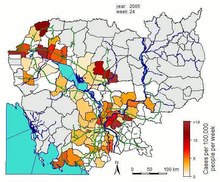Cumulative incidence or incidence proportion is a measure of frequency, as in epidemiology, where it is a measure of disease frequency during a period of time. Where the period of time considered is an entire lifetime, the incidence proportion is called lifetime risk.
Cumulative incidence is defined as the probability that a particular event, such as occurrence of a particular disease, has occurred before a given time. It is equivalent to the incidence, calculated using a period of time during which all of the individuals in the population are considered to be at risk for the outcome. It is sometimes also referred to as the incidence proportion.
Cumulative incidence is calculated by the number of new cases during a period divided by the number of subjects at risk in the population at the beginning of the study.
It may also be calculated by the incidence rate multiplied by duration:
See alson>

- Attack rate
- Epidemiology
References

- ^ Rychetnik L, Hawe P, Waters E, Barratt A, Frommer M (July 2004). "A glossary for evidence based public health". J Epidemiol Community Health 58 (7): 538â€"45. doi:10.1136/jech.2003.011585. PMC 1732833. PMID 15194712.Â
- ^ Dodge, Y. (2003) The Oxford Dictionary of Statistical Terms, OUP. ISBN 0-19-920613-9
- ^ Bouyer, Jean; Hémon, Denis; Cordier, Sylvaine; Derriennic, Francis; Stücker, Isabelle; Stengel, Bénédicte; Clavel, Jacqueline (2009). Épidemiologie principes et méthodes quantitatives. Paris: Lavoisier.Â



0 komentar :
Posting Komentar